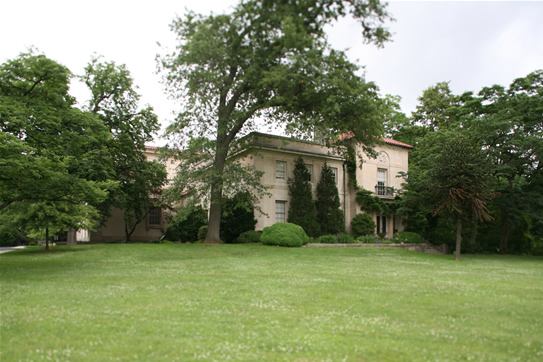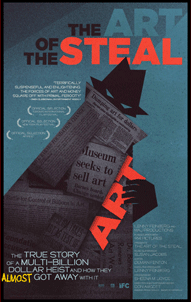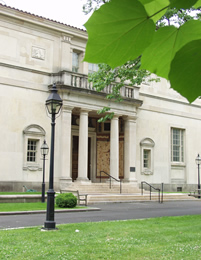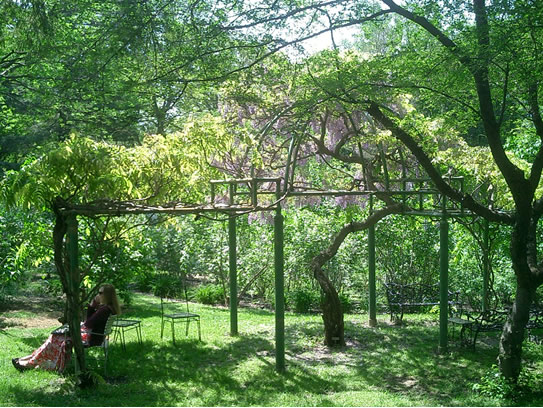The Barnes Foundation in Merion

The Barnes Foundation in Merion is known the world over as a unique
cultural site. Much more than an art collection, the Barnes is a remarkable
complex of art, architecture, and nature intrinsically bound to its site
in Merion, Pennsylvania, including:
• a respected school for art appreciation where students learn to “see” art
in a way that many students have found to be profound, even life changing;
• an esteemed horticultural school based on a mature Arboretum
whose plantings are integrated with the gallery and art collection,
and with many rare plant specimens;
• one of the most important privately held collections of art in the
world, estimated to be worth $20 - 30 billion;
• a gallery building designed for the art collection by Paul
Philippe Cret, eminent architect of the early 20th century, with works of art
by Henri Matisse and Jacques Lipchitz integrated into the structure.
Many who visit
the Barnes Foundation in Merion are struck by the intense immersion
of the experience. It was meant to be so and cannot
possibly be replicated elsewhere.
Many have written about the qualities that set the Barnes apart,
as you will see from the articles in our Commentary
Archive. The
following essay, “More Than An Art Collection,” explains
clearly the essence and importance of The Barnes Foundation in Merion.
The original essay was published in The Main Line
Times, Ardmore, Pennsylvania.
The Barnes Files
MORE THAN AN ART COLLECTION
By Sandra Gross Bressler
People ask, “What’s wrong with moving the Barnes art collection
to Philadelphia? It will stay intact and remain in the region.” This
line of thinking ignores the fact that the Barnes is much more than an
art collection. The Barnes Foundation is a unified whole which
includes the art and ethnographic collections, gallery building, arboretum
and educational programs. These
inter-related parts reinforce and support one another, providing what
is widely hailed as an aesthetic experience unique in the world.
Albert Barnes sought to understand art and was a visionary collector
with innovative tastes. The art gallery building was designed specifically
for his art collection by renowned architect, Paul Philippe Cret. With
John Dewey, America’s foremost educational philosopher, Barnes
developed an educational program for the study of art with based on the
unity of aesthetic expression, throughout time and across cultures. The
art gallery is installed according to those educational principles and
is the reason for the wall ensembles with their unusual, even staggering,
display of art and artifacts.
The gallery is situated in the midst of an extensive arboretum and sited
in relation to trees that were planted long before Barnes purchased the
property. The Arboretum and its educational program were developed
by Laura Barnes, based on the same principles as the art program. Trees
and plants were chosen to relate to specific works of art inside the
gallery and to the materials and design of the gallery building. The
Cousa dogwood trees in front of the gallery were selected because their
exfoliating bark mirrors the colors of the limestone façade and
the ceramic roof tiles.
The gallery building is a work of art unto itself, with Jacques Lipchitz
bas reliefs punctuating the limestone façade. The entryway is
of Enfield ceramic tiles, commissioned in an African mask motif, and
this theme continues through the exterior ironwork and on the friezes
inside the gallery. This recurrent African theme reflects Albert Barnes’ profound
respect for African American culture and prefigures his relationship
with Lincoln University.
Rising above the main gallery is the monumental mural, La Danse,
by Henri Matisse, which was commissioned, designed, and painted for this
specific location-- over the three arched windows that look out to the
Arboretum beyond. (Two museums in France devote gallery and exhibition
space to the history of this mural, which had to be painted twice, and
became a seminal work in Matisse’s career.) The shape of
Matisse’s arched mural is echoed in the stone well in the front
of the gallery and again in the shape of the wisteria arbor behind the
gallery.
The Barnes Foundation in its totality is an artistic masterpiece, thoughtfully
planned and executed by Albert and Laura Barnes. To remove the
art collection to Philadelphia is to destroy the incomparable experience
they wanted to pass on in perpetuity to future generations. In
fact, this will eviscerate the Barnes Foundation. Moving the art
collection to “save” the Barnes is the cultural equivalent
of the “successful” surgery that leaves the patient dead. This
will be the tragic case of tourism destroying the very thing it is seeking
to promote.
The Barnes is a magnificent gift, a visionary achievement, and an important
part of our cultural patrimony. Let us support, celebrate, and
honor an intact Barnes Foundation in Merion.
|






